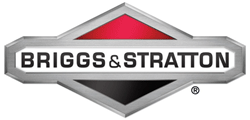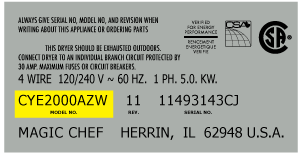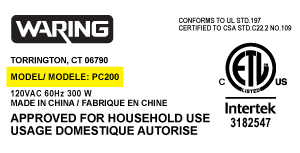6745 - Instructions
Keep searches simple. Use keywords, e.g. "leaking", "pump", "broken" or "fit".
Dryer Was Making A Lot Of Noise While Running
I ordered parts based off other peoples findings. I took the top and front off the dryer. I found the drum bearing(really only a plastic bracket. The slide were completely worn and the drum was wearing into the plastic drum bearing. I popped the old drum bearing out and put the new on in. There are actually 2 sets of slides (4 total). I only bought 2. I reused two of the existing slides. I put the unit back together and it was a lot quieter. I need to order more of the slides. They are only a couple dollars a piece and take most of the beating. I should've but didn't get the pasking or gasket. It was broken. I think it'll be fine though.
Parts Used:
-
Tracy from Winston Salem, NC
-
Difficulty Level:Really Easy
-
Total Repair Time:30 - 60 mins
-
Tools:Nutdriver, Screw drivers
47 of 54 people
found this instruction helpful.
Was this instruction helpful to you?
Thank you for voting!
selector knob cracked
ordered part on line--received in mail 2 days later--
just pushed on in 2 seconds--job done
how much easier can it get??????
just pushed on in 2 seconds--job done
how much easier can it get??????
Parts Used:
-
William from West End, NC
-
Difficulty Level:Really Easy
-
Total Repair Time:Less than 15 mins
74 of 137 people
found this instruction helpful.
Was this instruction helpful to you?
Thank you for voting!
The dryer was making noise.
I removed the two screws that hold the front panel to the top panel. I removed two more screws that hold the front panel to the side panels. I separated the front panel from the side panels and removed the drum.
I could see on the front panel the drum slides were badly worn. One was gone.
The new parts installed easily using no tools at all. Everything snaps in place. The new foam gaskets press and stick to seal the duct work. The felt strip pressed into place.
I replace all the panels in reverse order and plug it in. It operates fine, but the motor is making the noise. I will look into replacing the motor next.
I could see on the front panel the drum slides were badly worn. One was gone.
The new parts installed easily using no tools at all. Everything snaps in place. The new foam gaskets press and stick to seal the duct work. The felt strip pressed into place.
I replace all the panels in reverse order and plug it in. It operates fine, but the motor is making the noise. I will look into replacing the motor next.
Parts Used:
-
Joe from Eureka, CA
-
Difficulty Level:Easy
-
Total Repair Time:30 - 60 mins
-
Tools:Screw drivers
49 of 62 people
found this instruction helpful.
Was this instruction helpful to you?
Thank you for voting!
Broken belt
Removed the top of dryer two screws behind door at top then removed top two screws top corner lift dryer tub put belt around the tub then looped belt around the pullies.
Parts Used:
-
James from Charleston, MS
-
Difficulty Level:Really Easy
-
Total Repair Time:15 - 30 mins
-
Tools:Screw drivers
58 of 90 people
found this instruction helpful.
Was this instruction helpful to you?
Thank you for voting!
washer would not spin water out in heavy loads
You do not have to remove any water lines to do this repair. Just unplug the machine from the electric outlet and tip it up on its back to make the repair. I removed the old belt and parts per the instructions. The new kit does not look like the old one. Make sure you mark the minimum and maximum marks with a sharpie on the plastic pulley before intalling it. This will help line up the cam bearing to test the spin cycle. The repair kit says to use the thickest washer but mine would not fit on so I used the thinner washer. Keep the other washer so that in the future if the plastic part wears down and you have spinning problems again you can replace it with the thicker washer. Also make sure you buy a new belt and replace the belt. I loaded it up with a full load of jeans and it works great.
Parts Used:
-
marcus from mansfield, TX
-
Difficulty Level:A Bit Difficult
-
Total Repair Time:30 - 60 mins
-
Tools:Pliers, Screw drivers
43 of 48 people
found this instruction helpful.
Was this instruction helpful to you?
Thank you for voting!
washer would agitate, drain, but would not spin
I put the washer on the spin cycle and could see that the tub wanted to move. While it was trying to spin I leaned the washer forward and saw that the motor was spinning and the belt was turning, but the tub wasn't. Did some reading and it was the thrust bearing. I ordered the part and replaced them (very easy, follow the directions that come with the set). After install, the tub would spin.
Parts Used:
-
michael from mountain home, ID
-
Difficulty Level:Really Easy
-
Total Repair Time:15 - 30 mins
-
Tools:Screw drivers, Wrench (Adjustable)
43 of 48 people
found this instruction helpful.
Was this instruction helpful to you?
Thank you for voting!
Intermittent problem with lid switch, no high speed spin/pump out
Disconnect power, unsnap and raise machine top cover w/lid, remove old switch - two screws under lid, taking care to not drop loose actuator lever into machine. Remove control panel back and disconnect switch wire connector. Intall new switch, taking care to not drop loose actuator lever into machine, connect switch wires inside control panel. Replace panel cover and lower machine top cover w/lid and snap into place, reconnect power, verify operation...
Parts Used:
-
Linda from La Porte, IN
-
Difficulty Level:Easy
-
Total Repair Time:15 - 30 mins
-
Tools:Nutdriver, Screw drivers
47 of 62 people
found this instruction helpful.
Was this instruction helpful to you?
Thank you for voting!
The Dryer would not start
Doing some simple troubleshooting with the volt-ohm meter I determined that the door switch was failed.
The replacement door switch restored the motor circuit keeping my dryer in action.
The replacement door switch restored the motor circuit keeping my dryer in action.
Parts Used:
-
David from Curtice, OH
-
Difficulty Level:Really Easy
-
Total Repair Time:Less than 15 mins
-
Tools:Pliers
60 of 105 people
found this instruction helpful.
Was this instruction helpful to you?
Thank you for voting!
noise from the drum in the dryer
The weight of the front section of the drum in the dryer rides on 4 slim pieces of plastic. remove the screws that hold down the top of the dryer are in the front door at the top at each corner. remove the top, then remove 2 screws that hold down the front of the control panel to the cabinet at the base. remove the 2 screws at the of the front corners of the cabinet to separate the front door section from the rest of the dryer.Watch out for the wires the connect the door to the rest of the dryer. if you replace the bearing at the back of the dryer you need to take two screws out at the base of the cabinet one from each corner to let the sides of the cabinet to spread out and let the drum pass though the front of the dryer cabinet. the belt has to come off the motor by lifting it up an sticking your hand in under the drum and working it off the end of the motor. replaced the parts ad the dryer works like new.
Parts Used:
-
William from Blue Springs, MO
-
Difficulty Level:Easy
-
Total Repair Time:30 - 60 mins
-
Tools:Screw drivers
52 of 81 people
found this instruction helpful.
Was this instruction helpful to you?
Thank you for voting!
Noise at drum
1 Unplug power cord. 2 Remove top and front panels. 3 Remove old bearing, slides and bulb. 4 Install new bearing slides and bulb. Reinstall front and top panels. 5 Restore power and test. Time to repair 25 minutes. Very satisfied with the parts and the time to receive them, very good parts service. Will definately use this service in the future and will highly recommend this company.
Parts Used:
-
William from Sewell, NJ
-
Difficulty Level:Really Easy
-
Total Repair Time:15 - 30 mins
-
Tools:Pliers, Screw drivers
45 of 61 people
found this instruction helpful.
Was this instruction helpful to you?
Thank you for voting!
Washer shakes violently during spin cycle
I used the instructions from others and modified them with tips and details based on my own experience:
1. Unplug the power, turn off the hot/cold water valves and disconnect the hot/cold water hoses and drain hose. Tip: plug the drain hose with some paper towels to keep the stale water from dripping on your floors.
2. Move the washer to an open area like a garage, and position it near a wall (or have a helper on hand who can help you prop up the washer top later). Tip: to simplify things, you’ll want to avoid removing the top completely. Removing the top completely involves removing the inlet water hose and all wires leading to the control panel and the door switch.
3. Lay the washer on its side and remove the drive belt from the bottom of the washer.
4. Place the washer upright again and remove the lower rear panel held by eight ¼” hex screws.
5. With the rear panel off, you will see a black drain hose that connects the tub to the pump. Remove the hose at the pump with a pair of pliers. The hose is just held on with a spring clamp.
6. Remove the front panel: pry the top off at 2 front hinge points with a flat head screwdriver. With the top up, remove two 5/16” hex screws holding the front panel and remove the front panel.
7. Remove suspension springs: To easily remove the suspension springs, you will need about 12 quarters (or nickels) for each spring. I hope I can describe this part clearly. For the removal of each spring, tilt the top of the tub away from you as far as you can in order to stretch out the spring. Now insert coins between the gaps in the spring coil, alternating the coins on each side of the coil to keep the spring coil straight. Then tilt the top of the tub back toward you to release the tension on the spring and you should now be able to easily unhook the spring from the tub. The coins keep the coil stretched out for re-installation later. Repeat for the other 5 coils. Note: Others have mentioned using a metal electrical box for this, but I can’t visualize it.
8. Now raise the washer top and prop it against the wall (or have a helper hold it vertical). Follow the small clear “water level” hose that runs from the control panel to the rear of the tub and disconnect it from the tub. It is just held by a small spring clamp.
9. Remove the tub assembly. Remember the position of the tub before you take it out. Place a couple of 4”x4”s (or equivalent) on the ground to support the edges of the washer tub when you turn it upside down. With the springs removed, the drive belt off, and the water level hose and drain hose detached, you should be able to simply lift the tub assembly out. Lay the tub upside down on the 4x4s.
10. Remove the snubber ring: There is no need to remove the flywheel if you have a small or fairly shallow socket (or an angled open end wrench). My small socket worked fine. As others have mentioned, remove the snubber ring by backing out the six 5/16” hex bolts that hold the snubber ring in place. Do not remove the bolts completely. The metal retaining plate is supposed to be under spring tension, but mine did not rise when I loosened the bolts, so I had to pry it up slightly with a flat screwdriver to form enough of a gap to insert the new snubber ring. Make sure the new snubber ring is seated evenly and re-tighten the 6 bolts.
11. Reinstall: Place tub back into the cabinet, reconnect the thin water level hose, reconnect the drain hose at the pump.
12. Spring re-installation: As you hook each spring to the tub, make sure the bottom of the spring is hooked properly to the bottom of the cabinet. Then tilt the top of the tub away from you to stretch the spring out in order to remove the coins. Then tilt it back toward you to remove the tension. Repeat for the other 5 springs.
13. Re-install the front panel and the rear panel and place the washer top back in place.
14. Lay the washer on its side to reinstall the drive belt.
15. Hook up your hot/cold water, drain hose, tur
1. Unplug the power, turn off the hot/cold water valves and disconnect the hot/cold water hoses and drain hose. Tip: plug the drain hose with some paper towels to keep the stale water from dripping on your floors.
2. Move the washer to an open area like a garage, and position it near a wall (or have a helper on hand who can help you prop up the washer top later). Tip: to simplify things, you’ll want to avoid removing the top completely. Removing the top completely involves removing the inlet water hose and all wires leading to the control panel and the door switch.
3. Lay the washer on its side and remove the drive belt from the bottom of the washer.
4. Place the washer upright again and remove the lower rear panel held by eight ¼” hex screws.
5. With the rear panel off, you will see a black drain hose that connects the tub to the pump. Remove the hose at the pump with a pair of pliers. The hose is just held on with a spring clamp.
6. Remove the front panel: pry the top off at 2 front hinge points with a flat head screwdriver. With the top up, remove two 5/16” hex screws holding the front panel and remove the front panel.
7. Remove suspension springs: To easily remove the suspension springs, you will need about 12 quarters (or nickels) for each spring. I hope I can describe this part clearly. For the removal of each spring, tilt the top of the tub away from you as far as you can in order to stretch out the spring. Now insert coins between the gaps in the spring coil, alternating the coins on each side of the coil to keep the spring coil straight. Then tilt the top of the tub back toward you to release the tension on the spring and you should now be able to easily unhook the spring from the tub. The coins keep the coil stretched out for re-installation later. Repeat for the other 5 coils. Note: Others have mentioned using a metal electrical box for this, but I can’t visualize it.
8. Now raise the washer top and prop it against the wall (or have a helper hold it vertical). Follow the small clear “water level” hose that runs from the control panel to the rear of the tub and disconnect it from the tub. It is just held by a small spring clamp.
9. Remove the tub assembly. Remember the position of the tub before you take it out. Place a couple of 4”x4”s (or equivalent) on the ground to support the edges of the washer tub when you turn it upside down. With the springs removed, the drive belt off, and the water level hose and drain hose detached, you should be able to simply lift the tub assembly out. Lay the tub upside down on the 4x4s.
10. Remove the snubber ring: There is no need to remove the flywheel if you have a small or fairly shallow socket (or an angled open end wrench). My small socket worked fine. As others have mentioned, remove the snubber ring by backing out the six 5/16” hex bolts that hold the snubber ring in place. Do not remove the bolts completely. The metal retaining plate is supposed to be under spring tension, but mine did not rise when I loosened the bolts, so I had to pry it up slightly with a flat screwdriver to form enough of a gap to insert the new snubber ring. Make sure the new snubber ring is seated evenly and re-tighten the 6 bolts.
11. Reinstall: Place tub back into the cabinet, reconnect the thin water level hose, reconnect the drain hose at the pump.
12. Spring re-installation: As you hook each spring to the tub, make sure the bottom of the spring is hooked properly to the bottom of the cabinet. Then tilt the top of the tub away from you to stretch the spring out in order to remove the coins. Then tilt it back toward you to remove the tension. Repeat for the other 5 springs.
13. Re-install the front panel and the rear panel and place the washer top back in place.
14. Lay the washer on its side to reinstall the drive belt.
15. Hook up your hot/cold water, drain hose, tur
Parts Used:
-
Hank from Alpharetta, GA
-
Difficulty Level:Easy
-
Total Repair Time:1- 2 hours
-
Tools:Pliers, Socket set
37 of 42 people
found this instruction helpful.
Was this instruction helpful to you?
Thank you for voting!
Puddling on the floor. Water was leaking through the impeller bushing on the water pump
..First I sought the source of the water leak, by removing the louvered panel on the rear (4 nut headed screws hold it in place) and observed for water leaks during a wash cycle. This required that I re-position the washer and route the fill and drain hoses in order to stand behind the washer during its cycle to observe through the rear panel opening.
...There was no visible leakage of any of the hoses or connections but I could see the water puddle on the floor was coming from under the water pump located in the front corner.
...I wasn't able to peel the sides off the washer. I disconnected the rear hoses for hot and cold water and the drain hose. I removed the plate on the rear that orients the drain hose.
...I tilted the washer 90 degrees to its front using 2 x 4's to cushion the front so the machine would not be scratched.
....I removed the drive belt underneath. It was easy to remove by hand and did not require loosening screws on any of the pulleys.
...I disconnected the black exhaust hose from the tub with a screw driver and the white drain outlet hose with water pump pliers.
...I then reached into the front corner of the machine through the opening in the back and removed the water pump which is held in place by 3 nut head screws. I used a ratchet set to do this.
...I observed the water pump which is almost all molded plastic. The bushing area in the center attached to the impeller appeared to be wet and rusted. I assumed this to be the source of the water leak. I found the replacement on line at PartSelect site and ordered it. It was much cheaper at PartSelect then other sites.
....When the replacement pump arrived 2 days later , I compared it to the pump I removed. It matched physically including the pulley so then I installed it and re-assembled the washing machine in the reverse order from disassembly.
...I left the louvered panel off and observed the water flow for leaks during the first wash after re-assembly.
...There were no internal leaks and no puddling on the floor, so I replaced the louvered panel and put the washing machine back in place.
The water pump was a bit noisy during the 1st load
but otherwise the machine ran well. After the 1st load the pump is quiet and the machine runs just as it did before the puddling occurred. It is fine.
After having done this I can say, it was uncomfortable and cramped to reach in through the rear panel opening to remove and replace the water pump. But I could not find a way to lift the top of the machine easily so I could removed the side panels to have better access to the water pump and hoses. If anyone knows a way to do that without unplugging and removing the electronics panel, that would be useful information. Please post it.
It can be done the way I described here because I did it, but that may not be the easiest way if the side panels can be easily removed it would probably be an easier repair.
...There was no visible leakage of any of the hoses or connections but I could see the water puddle on the floor was coming from under the water pump located in the front corner.
...I wasn't able to peel the sides off the washer. I disconnected the rear hoses for hot and cold water and the drain hose. I removed the plate on the rear that orients the drain hose.
...I tilted the washer 90 degrees to its front using 2 x 4's to cushion the front so the machine would not be scratched.
....I removed the drive belt underneath. It was easy to remove by hand and did not require loosening screws on any of the pulleys.
...I disconnected the black exhaust hose from the tub with a screw driver and the white drain outlet hose with water pump pliers.
...I then reached into the front corner of the machine through the opening in the back and removed the water pump which is held in place by 3 nut head screws. I used a ratchet set to do this.
...I observed the water pump which is almost all molded plastic. The bushing area in the center attached to the impeller appeared to be wet and rusted. I assumed this to be the source of the water leak. I found the replacement on line at PartSelect site and ordered it. It was much cheaper at PartSelect then other sites.
....When the replacement pump arrived 2 days later , I compared it to the pump I removed. It matched physically including the pulley so then I installed it and re-assembled the washing machine in the reverse order from disassembly.
...I left the louvered panel off and observed the water flow for leaks during the first wash after re-assembly.
...There were no internal leaks and no puddling on the floor, so I replaced the louvered panel and put the washing machine back in place.
The water pump was a bit noisy during the 1st load
but otherwise the machine ran well. After the 1st load the pump is quiet and the machine runs just as it did before the puddling occurred. It is fine.
After having done this I can say, it was uncomfortable and cramped to reach in through the rear panel opening to remove and replace the water pump. But I could not find a way to lift the top of the machine easily so I could removed the side panels to have better access to the water pump and hoses. If anyone knows a way to do that without unplugging and removing the electronics panel, that would be useful information. Please post it.
It can be done the way I described here because I did it, but that may not be the easiest way if the side panels can be easily removed it would probably be an easier repair.
Parts Used:
-
Richard from Boyertown, PA
-
Difficulty Level:A Bit Difficult
-
Total Repair Time:1- 2 hours
-
Tools:Pliers, Screw drivers, Socket set
35 of 38 people
found this instruction helpful.
Was this instruction helpful to you?
Thank you for voting!
Washer Made Screeching noise on spin & Rinse
Unplugged Machine, Turned Off Water, Disconnected water and drain hoses. Let water run from hoses ino bucket.
Removed back plate where drain hose goes into back of machine. Used pliers to close the clamp holding to drain hose to remove it. I stuffed the exposed water pump opening with towels to keep water from spilling.
At this point I leaned the machine over on its front so the back of the machine was facing skyward. I placed a towel over the motor in case water spilled it would not get on the electrical components. I removed the belt on the bottom of the machine from the water pumps pully. I then removed the three screws mounting the pump to the bottom of the machine. I disconnected the other hose from the water pump that comes from the wash tank with the pliers. Once disconnected I stuffed the ends of both with towels to keep water from leaking out.
I took the new pump and connected the hose from the washer tub with pliers, mounted the pump back to the bottom of the tub with the three screws, replaced the belt, and reconnected the drain hose, and took the towel off the motor. I then replaced the back plate and set the machine upright. I connected all the hoses back up and plugged it in. It worked great. If you spill water on the motor you can dry it with a hair dryer.
Removed back plate where drain hose goes into back of machine. Used pliers to close the clamp holding to drain hose to remove it. I stuffed the exposed water pump opening with towels to keep water from spilling.
At this point I leaned the machine over on its front so the back of the machine was facing skyward. I placed a towel over the motor in case water spilled it would not get on the electrical components. I removed the belt on the bottom of the machine from the water pumps pully. I then removed the three screws mounting the pump to the bottom of the machine. I disconnected the other hose from the water pump that comes from the wash tank with the pliers. Once disconnected I stuffed the ends of both with towels to keep water from leaking out.
I took the new pump and connected the hose from the washer tub with pliers, mounted the pump back to the bottom of the tub with the three screws, replaced the belt, and reconnected the drain hose, and took the towel off the motor. I then replaced the back plate and set the machine upright. I connected all the hoses back up and plugged it in. It worked great. If you spill water on the motor you can dry it with a hair dryer.
Parts Used:
-
Michael from Elgin, SC
-
Difficulty Level:Really Easy
-
Total Repair Time:30 - 60 mins
-
Tools:Nutdriver, Pliers
34 of 37 people
found this instruction helpful.
Was this instruction helpful to you?
Thank you for voting!
Dryer would not start
The switch made a humming sound when I turned it so I thought that might be the problem. Using the instructions on this Web site I took the top panel of the dryer off (after unplugging it), unplugged two wires leading from the switch (needed pliers for this), and removed the switch unit by rotating it counterclockwise (when behind it).
The replacement part came in two days. The installation went a lot quicker-maybe ten minutes.
The replacement part came in two days. The installation went a lot quicker-maybe ten minutes.
Parts Used:
-
Ray from Kingwood, TX
-
Difficulty Level:Easy
-
Total Repair Time:30 - 60 mins
-
Tools:Pliers, Screw drivers
33 of 37 people
found this instruction helpful.
Was this instruction helpful to you?
Thank you for voting!
Squeaking Dryer - Rear Drum bearing gone bad
First, I loosened the the top control panel and then loosened the top flat roof panel which allowed me access to the inside of the dryer. Then, I removed the front panel which allowed access to the drum. I was amazed at the amount of lint that was inside the dryer itself. Most of my time was spent in the disassembly and cleaning of the internal cavity around the drum. I reached below the drum and removed the belt from the pulley wheels and then unscrewed the drum (from the inside) from the back of the dryer and bearing kit. I removed the diffuser and cleaned it thoroughly. Then I replaced the entire drum bearing kit - the old one was almost completely dissentigrated. I probably should have applied some kind of non-flammable lubricant to the new bearing kit - the instructions did not include this step but after about 3 loads a slight squeak (different). I put everything back together - applying the new drum kit will require 2 sets of hands (my 9-year old daughter did great at this). I re-assembled the dryer and it works great, again except for the slight squeak that's still there. I may disassemble it again and apply some lubricant but I do not know what kind to get; I need to check that out.
Parts Used:
-
Jason from Cary, NC
-
Difficulty Level:A Bit Difficult
-
Total Repair Time:More than 2 hours
-
Tools:Screw drivers, Socket set
32 of 35 people
found this instruction helpful.
Was this instruction helpful to you?
Thank you for voting!








































